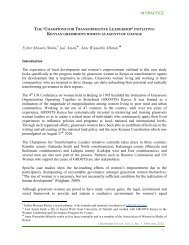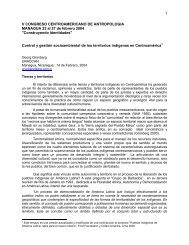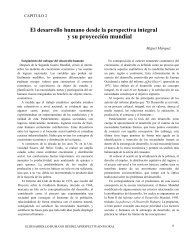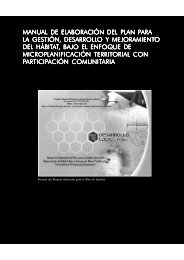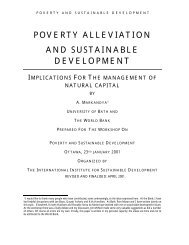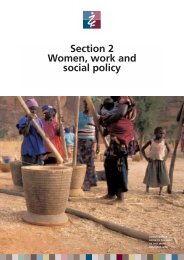The Cluster Initiative Greenbook
The Cluster Initiative Greenbook
The Cluster Initiative Greenbook
You also want an ePaper? Increase the reach of your titles
YUMPU automatically turns print PDFs into web optimized ePapers that Google loves.
Policy and the business environment<br />
<strong>The</strong> general business environment, see Figure 14, imposes certain almost deterministic<br />
forces from history, geographical position, and culturally-bound institutions (1). Policy<br />
choices on the other hand, offer opportunities for citizens to shape the future of their<br />
society. On the economic side, macroeconomic policy (2) influences the general business<br />
environment, and microeconomic policies (3) – including cluster initiatives, which<br />
serve to “lubricate” the microeconomic “engine” – directly influence the diamond and<br />
clusters. Strategies formed within firms and entrepreneurial activities (4) are other proactive<br />
forces shaping clusters and society.<br />
Macroeconomic<br />
policy<br />
2<br />
1<br />
General business environment<br />
Microeconomic<br />
policy<br />
3<br />
Diamond<br />
CI<br />
<strong>Cluster</strong><br />
4<br />
Firm<br />
Figure 14<br />
<strong>The</strong> business environment and<br />
forces of change<br />
<strong>The</strong> role of historic and geographic determinism can, for example, be seen in the<br />
aftermath of the fall of the Soviet Union. Many transition countries in Eastern Europe<br />
were advanced societies in the beginning of the 20th century, including Estonia, Poland,<br />
Hungary and other nations. Some nations have only been prosperous in certain<br />
regions, such as Moscow and St Petersburg in Russia. Others were late industrialisers<br />
and have a less advanced legacy, including Bulgaria and Romania. Geographical determinism<br />
is seen in Estonia’s proximity to Finland and the Nordic region, which gave the<br />
country a head start in the 1990s. <strong>The</strong> same goes for Slovenia, with its historic ties to<br />
Western Europe. Overall, proximity to Western Europe has been one of the stronger<br />
predictors of economic growth after 1990 in Eastern and Central Europe.<br />
Successful clusters are linked to global markets<br />
Firms are shaped by the national business environment, but are also linked to the<br />
global marketplace in various ways. In most industries today, global markets offer a<br />
way for firms to enhance efficiency through improved economies of scale in varying<br />
parts of the value chain: sourcing of materials, components, machinery and services,<br />
low-cost manufacturing, and access to larger markets. Depending on homogeneity of<br />
demand, trade restrictions, transportation costs and homogenisation of technology,<br />
global sales can involve more or less local adaptation and design and more or less<br />
dispersion of packaging, assembly, testing, and production. <strong>The</strong> more a firm faces one<br />
homogenous market, with few or no trade barriers, and the lower the transportation<br />
costs, the more one global source for development and production can be used.<br />
However, in many industries some fragmenting forces still prevail, forcing multinational<br />
corporations to run dispersed operations, often reducing some of the potential<br />
global scale advantages.<br />
<strong>The</strong> <strong>Cluster</strong> <strong>Initiative</strong> <strong>Greenbook</strong> • 23




